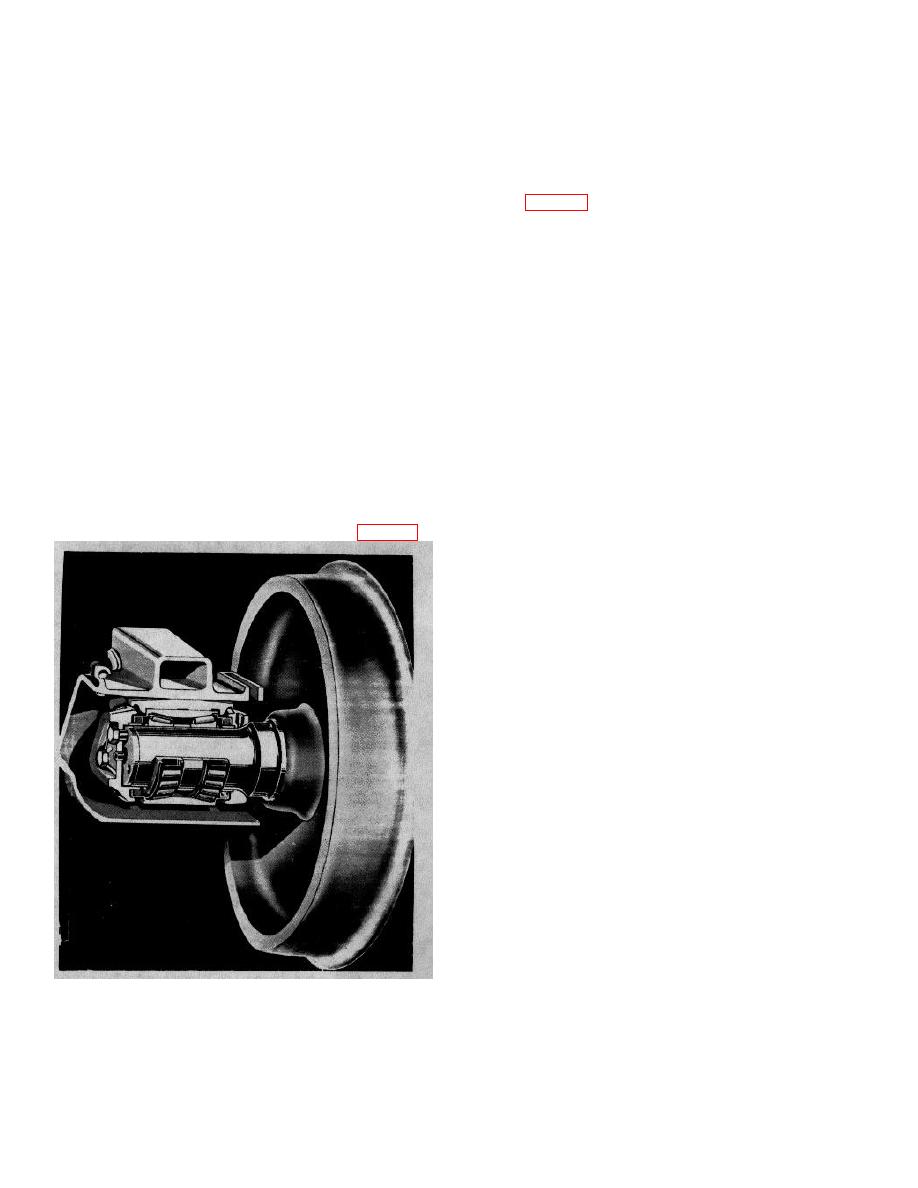
TM 55-203
of "hot-box" problems, better riding qualities for the car,
b. Dry or Misplaced Packing. If the packing has
and lessened wheel and truck wear. Roller bearings are
settled away from the journal for any portion of its length
manufactured by various commercial concerns in
or if the back roll is not in contact with the journal fillet, a
CONUS of two general types-cylindrical and tapered
dry spot develops and overheating results.
The
hard steel bearings fitted snugly to the axle journal. The
accepted method of 'detecting misplaced packling is
tapered bearing is illustrated in figure 4-23(1). The
examination with the standard packing iron or packing
component parts of another bearing are shown in figures
hook (fig 4-24). Dry packing is corrected by adding free
4-23(2) and 4-23(3).
oil. However, too much oil makes the packing soggy
and causes thread and lint to stick to a cold journal.
c. Loose or Overrun Lining. If the bearing lining is
4-9. Causes of Hotboxes
overrun, it interferes with the proper oil circulation and
prevents oil from following the journal into the load-
a. Waste Grab. Threads or particles of waste
bearing area. Loose or overrun lining can be detected
between the bearing and the journal act as an oil wipe
with the lining or waste grab hook when checking for
and cause a dry spot. Waste grab may be caused by
waste grab.
loose threads and lint wedging (a waste grab) between
d. Water in Packing. In freezing weather, water
the bearing and journal. Loose threads must be tucked
freezes in the waste threads and shuts off the capillary
under, and packing must be free from lint. Wedging is
action which carries oil to the journal. It may cause the
most likely when a standard size bearing is applied to a
packing to adhere to the journal and become badly
minimum size journal or one which is worn close to the
misplaced. Water also gets under the oil when it does
limit. Packing which is rolled up on one side of the box
not freeze and displaces oil from the back of the box
is an invitation to waste grab. Rough handling in yards
through the dust-guard well. Loose or poorly fitting lids
or severe buffing shocks in trains may cause
admit snow and cause water trouble.
displacement of the bearing on the journal for an instant,
e. Dripping Brine. Brine dripping from refrigerator
long enough for bits of waste to get under the bearing.
cars causes trouble if it enters the journal box. It is
The method of detecting waste grab is to feel along the
corrosive and can cause rough spots on journals.
edge of the bearing with the waste grab hook (fig 4-24).
f. Flat or Rough Wheels. Flat or rough wheels cause
a pounding which settles the packing away from the
journal and breaks the oil film under the bearing.
g. Overloaded Cars. Common causes of hotboxes
are overloaded cars, or cars having misplaced or shifted
lading which increases the load on one or more journal
boxes.
h. Defective Trucks. Trucks which are out of square
or which do not swivel freely owing to binding of side
bearings or dry center plates may contribute to
overheated bearings.
i. Axles. Bent axles may cause hotboxes. If an axle
is bent between wheels, the wheel tread will show
uneven wear. Bearings on bent axles will also show
tapered wear, and if allowed to continue in service may
become badly damaged by overheating. The bearing
on the other end of the axle should be examined as a
precaution if a bent axle is suspected.
j. Truck Bolster Springs and Snubbing Devices.
Defective or improperly applied coil springs and
snubbing devices may result in hotboxes.
Figure 4-23(1). Tapered roller bearing.
4-16


 Previous Page
Previous Page
